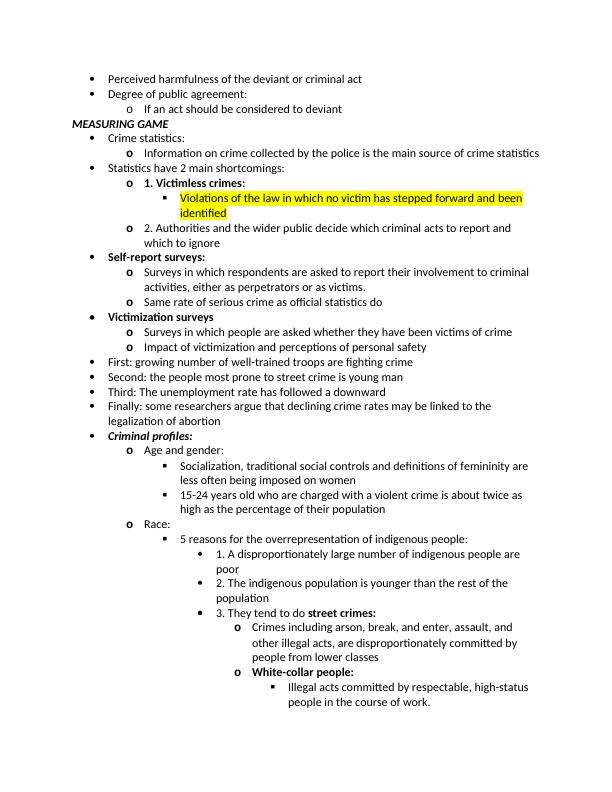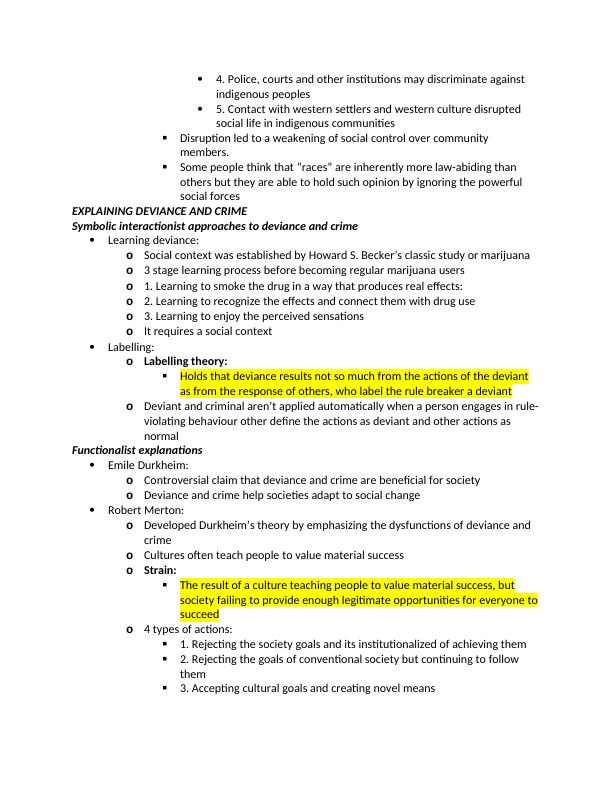Chapter 5 : Deviance and Crime
Added on 2020-11-30
7 Pages1690 Words114 Views
Chapter 5: Deviance and CrimeLearning objectives: See how people define deviance and crime differently in different times and placesInterpret differences in crime rates over time and between different population categoriesApply a variety of sociological theories to the analysis of various aspects of deviant and criminal behaviourLearn how forms of punishment have changed historically Explain how fear of crime is subject to manipulation by political and commercial groups that benefit from itIdentify workable alternatives to tough prison regimesTHE SOCIAL DEFINITION OF DEVIANCE AND CRIMENorms vary widely Deviance is relativeFrom a sociological point of view everyone is deviant in one social context or another The difference between deviance and crime Deviance: oDeparture from a norm that evokes a negative reaction from others. Some norms are lawsCrime: oDeviance that is against the lawLaw: oA norm stipulated and enforced by government bodiesNorms and laws have changed dramatically SANCTIONS: Deviant acts go unnoticed or are considered too trivial to warrant negative sanctions or actions indicating disapproval Formal punishment: oPenalization by the judicial system for breaking a law Ex: criminals are usually formally punished by having to serve time in prison, pay a fine or perform community serviceInformal punishment: oA mild sanction that is imposed during face-to-face interaction rather than by thejudicial systemRaised eyebrows, harsh stare, ironic smile, gossip, ostracism, “shaming” or stigmatizations: Stigmatizations: oProcess of negatively evaluating people because of a marker that distinguishes them from othersNegatively evaluated because of visible characteristics that distinguish them from others Deviance and crime vary in terms of the severity of the social responseoMild disapproval to capital punishment

Perceived harmfulness of the deviant or criminal actDegree of public agreement: oIf an act should be considered to deviant MEASURING GAMECrime statistics: oInformation on crime collected by the police is the main source of crime statisticsStatistics have 2 main shortcomings: o1. Victimless crimes: Violations of the law in which no victim has stepped forward and been identifiedo2. Authorities and the wider public decide which criminal acts to report and which to ignore Self-report surveys: oSurveys in which respondents are asked to report their involvement to criminal activities, either as perpetrators or as victims. oSame rate of serious crime as official statistics do Victimization surveysoSurveys in which people are asked whether they have been victims of crimeoImpact of victimization and perceptions of personal safety First: growing number of well-trained troops are fighting crimeSecond: the people most prone to street crime is young man Third: The unemployment rate has followed a downwardFinally: some researchers argue that declining crime rates may be linked to the legalization of abortionCriminal profiles: oAge and gender: Socialization, traditional social controls and definitions of femininity are less often being imposed on women 15-24 years old who are charged with a violent crime is about twice as high as the percentage of their population oRace: 5 reasons for the overrepresentation of indigenous people: 1. A disproportionately large number of indigenous people are poor 2. The indigenous population is younger than the rest of the population 3. They tend to do street crimes: oCrimes including arson, break, and enter, assault, and other illegal acts, are disproportionately committed by people from lower classes oWhite-collar people: Illegal acts committed by respectable, high-status people in the course of work.

4. Police, courts and other institutions may discriminate against indigenous peoples5. Contact with western settlers and western culture disrupted social life in indigenous communities Disruption led to a weakening of social control over community members.Some people think that “races” are inherently more law-abiding than others but they are able to hold such opinion by ignoring the powerful social forcesEXPLAINING DEVIANCE AND CRIMESymbolic interactionist approaches to deviance and crimeLearning deviance: oSocial context was established by Howard S. Becker’s classic study or marijuana o3 stage learning process before becoming regular marijuana userso1. Learning to smoke the drug in a way that produces real effects: o2. Learning to recognize the effects and connect them with drug useo3. Learning to enjoy the perceived sensationsoIt requires a social context Labelling: oLabelling theory: Holds that deviance results not so much from the actions of the deviant as from the response of others, who label the rule breaker a deviantoDeviant and criminal aren’t applied automatically when a person engages in rule-violating behaviour other define the actions as deviant and other actions as normalFunctionalist explanationsEmile Durkheim: oControversial claim that deviance and crime are beneficial for society oDeviance and crime help societies adapt to social change Robert Merton: oDeveloped Durkheim’s theory by emphasizing the dysfunctions of deviance and crimeoCultures often teach people to value material successoStrain: The result of a culture teaching people to value material success, but society failing to provide enough legitimate opportunities for everyone tosucceedo4 types of actions: 1. Rejecting the society goals and its institutionalized of achieving them 2. Rejecting the goals of conventional society but continuing to follow them 3. Accepting cultural goals and creating novel means

End of preview
Want to access all the pages? Upload your documents or become a member.
Related Documents
Crime and Sociology: Understanding the Nature of Crime and Contextualizing Punishmentlg...
|9
|2427
|398
Assignment about What is Criminology?lg...
|8
|2253
|16
Sociology of Deviant Behaviour - Understanding the Relevance and Timely Topicslg...
|6
|1687
|137
Deviant Behaviour: Definition, Changes, and Societal Viewslg...
|4
|818
|90
Informal Sanctions and Deviant Behavior in Legal Justice Systemlg...
|5
|1158
|143
State and Government as a Deviantlg...
|5
|1342
|261
